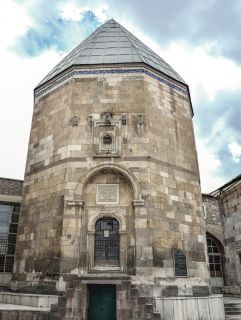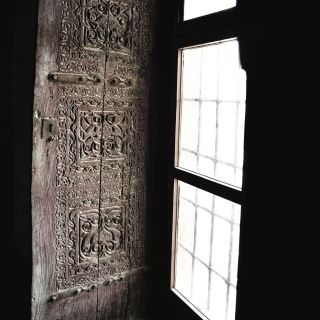TOMB OF SULTAN QILICH ARSLAN II
Turkiye KONYA 12th Century
This tomb is located in the courtyard of the Alâeddin Mosque downtown Konya.
The two-storey monument has a decagonal body rising on a high socle and crowned with a dome inside and a pyramidal roof outside.
Two flights of stairs lead up to the doorway on the northeast side. The doorway is placed in a tall niche surmounted with a pointed arch. The row of dark coloured stone starting from the top of the arch divides the tall body into two. The only window at the lower level is on the east side. In the upper part are three slit windows, one of which is located over the doorway. The slit window over the entrance has an inscription giving the name of the master and date of construction. Over the slit window are five consoles.
The inner space of the tomb proper is accessed via a doorway topped with a Bursa-style arch; the interior is surrounded with semi-circular niches starting from the floor level reaching up to the bottom of the dome drum.
A doorway beneath the landing of the stairs leading up allows access into the crypt, which is circular in layout and covered with a dome and illuminated with four slit windows.
The tomb is faced entirely with dressed stones on the exterior and interior but the crypt was built with rubble. The pyramidal roof concealing the dome is currently covered with lead sheeting.
Like its architectural decoration, the tile decoration of the structure is also of great importance and value for their time. Arches encircled with profiled mouldings and consoles on the entrance façade, slit windows placed in profiled frames and the planimetry of the interior are worth noting. Carved stone band with floral decoration framing the entrance doorway and the reused stone plaque placed in an arched niche enrich the façade. Although it is known that the pyramidal roof was originally faced with tiles there is not a single trace surviving today. Tile decoration is seen only in the band running around the body just underneath the profiled eaves cornice. This band is decorated with the Verse of the Throne in calligraphy. Right underneath this band is another band carved on dark coloured stone with calligraphy giving information about the patron of the tomb.
The door wings are among the most authentic woodwork examples of the period. The interior of the tomb proper houses eight cenotaphs decorated with tiles and belonging to eight sultans of the Anatolian Seljuk Sultanate. Four of the cenotaphs have lost their tile veneer entirely.
Having undergone repairs at various times, the monument has lost some of its authenticity but today it is in good condition. The decorated tile facing of the pyramidal roof and the architectural element once carried by the consoles over the window on the entrance façade have not survived; and the brick facing of the dome has been replaced with stone facing.
Although the construction date of the tomb is not known the inscription reveals that it was built before the death of Sultan Qilich Arslan II in 1192. The architect of the monument was Yusuf, son of Abd al-Gaffar, of Hojan.



